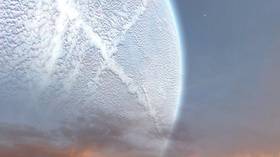Alien life could thrive on hydrogen worlds says new study, forcing rethink of how we hunt for ET

New research indicates that organic life could thrive on planets with hydrogen-dense atmospheres, throwing the search for extraterrestrial life wide open, just as the next generation of space telescopes comes online.
Astronomer Sara Seager, professor of Planetary Science, Physics, and Aeronautics and Astronautics at MIT, is wary of our "terra-centric" view of life and wanted to explore what other kinds of habitats beyond Earth might foster life – just not necessarily oxygen-dependent, carbon-based life as we know it.
We already know of organisms – such as methanogens – here on Earth which thrive in extreme conditions, deep below the ice sheets or in desert soil where they consume hydrogen and carbon dioxide and produce methane, but what if more developed versions of these organisms evolved out there in the universe, and we’d been missing them all along?
Also on rt.com ‘Of course we are not alone’: Russian scientist says we’re using wrong tools to hunt for aliensSeager and her team studied two microbes' tolerance to 100 percent hydrogen environments: the first was the bacteria Escherichia coli, and the second, yeast. Both of these can survive with and without oxygen, making them the ideal candidates to test the viability of hydrogen worlds for supporting life.
The team grew cultures of each organism and then placed them in separate bottles filled with a nutrient-rich "broth" off which they could feed. They then removed the oxygen-rich air and replaced it with pure hydrogen gas.
The bottles were then placed in an incubator where they were gently agitated to promote the mixing of the cultures with the nutrients in the hydrogen environment and sampled every hour for 80 hours. The results were as conclusive as it gets: the microbe populations thrived.
While the results were somewhat unsurprising, given that hydrogen is inert and so not inherently toxic to organic life, they do mean that our search for extraterrestrial life can and must include hydrogen worlds. The team's findings have been published in the journal Nature Astronomy.
Also on rt.com NASA planet-hunting probe finds its 1st Earth-sized world in habitable zone sweet spotHydrogen is much lighter than oxygen or nitrogen, so a hydrogen world's atmosphere would extend much further out from the planet’s rocky surface, making them easier to spot and easier to study than smaller, Earth-like exoplanets, especially when next generation telescopes like NASA's upcoming James Webb Space Telescope come online.
"There's a diversity of habitable worlds out there, and we have confirmed that Earth-based life can survive in hydrogen-rich atmospheres," Seager said.
We should definitely add those kinds of planets to the menu of options when thinking of life on other worlds, and actually trying to find it.
Saeger also posited what a hydrogen world might look like and it sounds not too dissimilar to our own home world: "We're imagining if you drill down into the surface, it probably would have hydrogen-rich minerals rather than what we call oxidized ones, and also oceans, as we think all life needs liquid of some kind, and you could probably still see a blue sky."
Think your friends would be interested? Share this story!














